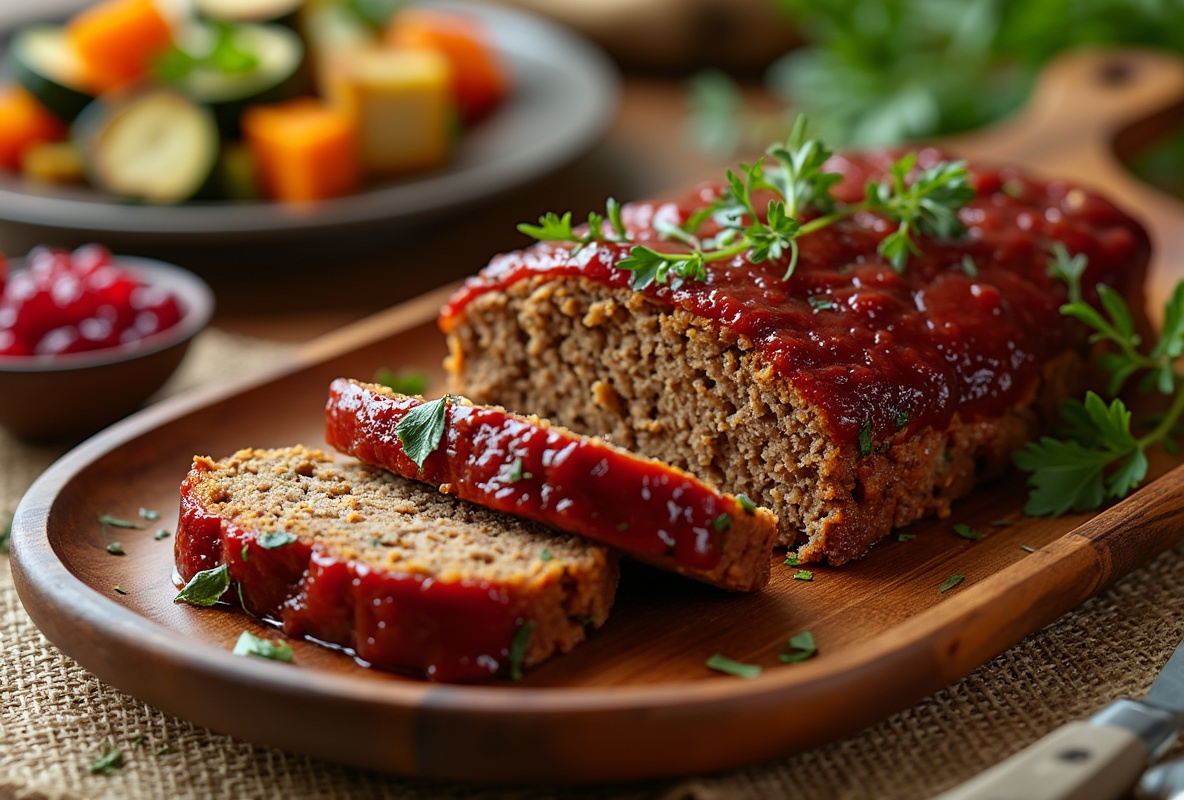Discovering the Moisture Magic in Meatloaf
Have you ever wondered what the Moist Meatloaf Recipe Secret is? Well, you're in for a treat. Many of us have battled with dry, crumbly meatloaf in the past, but the journey to discovering that perfect, juicy bite is filled with exciting flavors and simple techniques. I love how a few small adjustments can transform a standard dish into something mouthwateringly delicious. In this section, we will explore the foundational steps to uncover the moist magic in meatloaf, setting the stage for irresistibly tender results every time.
Essential Ingredients for a Succulent Meatloaf
Creating a moist and flavorful meatloaf begins with selecting the right ingredients. I've found that a crucial component is using a mix of meats—such as beef, pork, or even turkey—for a harmonious blend of flavors and juices. But for those embracing a plant-based lifestyle, don't worry! You can still create a delicious, moist plant-based meatloaf with ingredients like lentils, beans, or mushrooms. Next, it's essential to incorporate binders and fillers like breadcrumbs or oats, which not only hold everything together but also soak up juices to prevent dryness. Another favorite trick of mine is adding finely diced vegetables, like onions, carrots, or bell peppers. These not only infuse the loaf with flavor but also contribute to its moisture content. Incorporating eggs or flaxseed meal can help further bind and enrich the texture. Lastly, never underestimate the power of well-chosen spices and herbs; they breathe life into any dish and keep the taste buds eager for more. With the right balance of these ingredients, you're well on your way to meatloaf magic!
The Secret Technique for a Moist Meatloaf Recipe
To truly unlock the magic of a Moist Meatloaf Recipe Secret, it involves an unexpected yet simple technique. As I've experimented in my own kitchen, I've discovered that the key lies in incorporating mirepoix. This classic French blend of finely chopped onions, carrots, and celery not only enriches the flavor but also lends crucial moisture to the meatloaf. Another essential component is soaking breadcrumbs or oats in milk or a plant-based alternative if you're going for a plant-based meatloaf twist. This creates a humid environment inside your meatloaf as it bakes, warding off any dreaded dryness. I'd also recommend mixing in an egg or flaxseed paste to tie everything together, ensuring each slice holds its juicy shape. If you try this combination of steps, you'll find they transform a simple meal into one that bursts with moisture and delight with every bite.
Preparing Your Ingredients: Tips for Juicy Results
When it comes to crafting a succulent plant-based meatloaf, getting your ingredients right is key. Here's what I've learned can make all the difference:
- Choose the Right Base: Start with a combination of lentils or black beans. These not only add flavor but also provide a moist texture.
- Bind and Moisturize: Adding ground oats or breadcrumbs can help bind the loaf. To keep it luscious, don’t forget a splash of vegetable broth or a spoonful of applesauce.
- Flavor with Vegetables: Finely chopped onions, bell peppers, and carrots not only boost taste but also release moisture as they cook, keeping the loaf tender.
- Season Generously: Consider spices like smoked paprika, garlic powder, and thyme. They weave in mouth-watering flavors without drying out the mixture.
Mix Gently: Overworking the mixture can result in a tough loaf. Mix just until everything comes together.
Incorporating these tips ensures your plant-based meatloaf stays juicy and flavorful from start to finish.
Cooking Methods to Preserve Meatloaf Tenderness
When it comes to cooking a delicious, plant-based meatloaf, the method can make all the difference between a tender delight and a dry disappointment. After spending time selecting fresh ingredients, you want to ensure that the cooking process enhances rather than detracts from your hard work. Here are a few tried-and-true techniques:
-
Low and Slow: Cook your meatloaf at a lower temperature, around 325°F (165°C), allowing the interior to cook evenly without drying out the exterior. It might take a little longer, but patience is key to achieving a moist texture.
-
Moisture-Rich Environment: Consider placing a pan of water in the oven to maintain humidity. This simple trick can help prevent the loaf from losing moisture in the dry oven heat.
-
Rest Before Slicing: Once your loaf is cooked, resist the temptation to slice immediately. Letting it rest for about 10-15 minutes allows juices to redistribute, ensuring each piece is as juicy as the next.
Remember, the right technique can elevate your cooking, ensuring your plant-based meatloaf maintains its deliciously soft and tender allure.
Common Mistakes That Dry Out Meatloaf
You know, making a plant-based meatloaf that's just right can be a bit of an art. I've learned there are a few common mistakes that can turn this savory dish into something less than perfect. First, not using enough binding agents can leave your loaf too crumbly. The lack of eggs in plant-based recipes means you need the right amount of breadcrumbs or oatmeal to hold everything together and maintain moisture.
Overmixing your ingredients can also be a culprit. When you mix too much, you compress everything and squeeze out the juices, leading to a dry texture. Try to handle the mixture as little as possible!
Baking at too high a temperature is another trap. When the oven's heat is too intense, it evaporates the moisture before the loaf is fully cooked. A moderate temperature ensures even cooking and keeps the loaf tender.
Finally, don't forget the resting period. Cutting into the meatloaf as soon as it’s out of the oven lets all those delicious juices run away. Letting it rest for a few minutes before slicing can make a world of difference in juiciness! Patience pays off—trust me.
Enhancing Flavor Without Sacrificing Moisture
When crafting the perfect plant-based meatloaf, balancing flavor and moisture is key. You might wonder how to keep things tasty without drying out your dish. Well, here’s the secret: start by adding finely chopped or pureed vegetables like onions, peppers, or mushrooms. These not only infuse your meatloaf with depth but also contribute to its juiciness. To further enhance the taste, consider incorporating bold seasonings such as smoked paprika, garlic powder, or Italian herbs. These pack a punch, ensuring every bite is flavorful. Another great trick is mixing in a touch of soy sauce or Worcestershire sauce—they're fabulous for that umami kick. At the same time, use binding agents such as oats, breadcrumbs, or even cooked quinoa to retain moisture. Lastly, brush your loaf with a glaze made from ketchup, mustard, or barbecue sauce before baking. This protective layer locks in moisture and adds a delightful tangy finish. Remember, it’s all about balancing these elements to create a delicious, juicy plant-based masterpiece.
The Moisture Magic in Plant-Based Meatloaf
Welcome to the delightful world of plant-based meatloaf. Let's explore how to achieve perfect moistness. Every bite is a flavor explosion with the right approach.
Essential Ingredients for a Succulent Meatloaf
Creating a juicy plant-based meatloaf starts with the essentials. You need plant-based proteins like lentils or chickpeas. Don’t forget breadcrumbs, flax eggs, and plenty of spices.
The Secret Technique for a Moist Meatloaf Recipe
Ah, the secret! It’s all in binding and hydrating. Use mashed veggies or a bit of oat milk to get the texture just right. It’s the trick to keep your loaf from drying out.
Preparing Your Ingredients: Tips for Juicy Results
Preparation is key. Chop and sauté onions, mushrooms, and red pepper finely. Keep them vibrant and fragrant for maximum moisture retention.
Cooking Methods to Preserve Meatloaf Tenderness
Bake your meatloaf in a gentle oven. A water bath can help maintain humidity. Covering with foil initially then browning at the end gives a succulent interior and perfect crust.
Common Mistakes That Dry Out Meatloaf
Avoid using too much filler like breadcrumbs. They soak up moisture. Skipping the binder? That can cause crumble chaos. Also, overhandling the mixture can lead to a dense loaf.
Enhancing Flavor Without Sacrificing Moisture
Want extra flavor? Unleash umami. Add nutritional yeast or soy sauce. Incorporate fresh herbs. Just ensure the balance to retain juiciness.
FAQ
How can I prevent my plant-based meatloaf from being crumbly?
Ensure you're using enough binding agents like flax eggs and don't overmix the ingredients.
What can replace breadcrumbs for a gluten-free version?
Use crushed gluten-free crackers or oats as an alternative to breadcrumbs.
How do I know when my meatloaf is fully cooked?
Check it with a thermometer; the internal temperature should be around 165°F for safety.
Can I freeze leftover plant-based meatloaf?
Absolutely, just wrap it tightly and store it in an airtight container for up to three months.
Is it okay to add vegetables without cooking them first?
Better to sauté them; this adds flavor and prevents water release that may affect the loaf’s texture.

